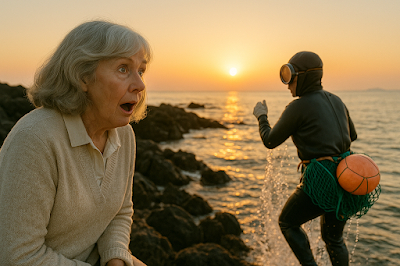They dive without oxygen tanks, harvest from the ocean floor, and surface with songs in their breath. Jeju’s haenyeo—free-diving women of the sea—are more than a cultural symbol. They are living legends of endurance, community, and heritage.
Step into the unique world of haenyeo culture, and discover how these remarkable women shaped Jeju’s identity—and how their legacy connects with other feminine traditions like Gyubang Darye.
1. Who Are the Haenyeo? A Legacy of Strength and Sea
Haenyeo (해녀) are Jeju women, many in their 60s to 80s, who dive into the sea to gather seafood like abalone, sea urchins, and seaweed without breathing equipment. Their roots go back centuries, when women took to the sea while men worked inland. Their lifestyle symbolizes resilience and matriarchal strength, with generations passing down skills through oral tradition and community training. Today, they represent a rare living heritage recognized by UNESCO.
2. Visit the Haenyeo Museum in Hado-ri
Located in eastern Jeju, the Haenyeo Museum offers deep insight into the history, tools, and rituals of haenyeo life. Exhibits showcase diving suits, harvest baskets, and underwater photography. You can listen to traditional haenyeo songs and even try on replica gear. The museum provides English translations and interactive media, making it foreigner-friendly and emotionally powerful. It’s a must-visit before heading to coastal villages.
3. Live Demonstrations and Village Experiences
In places like Seongsan or Hyeopjae, visitors can watch haenyeo dive in real time, often near low-tide rocky shores. Guided experiences allow tourists to meet retired haenyeo, listen to their stories, and even share a seafood tasting. Programs like “Haenyeo Experience” (offered seasonally) let you try shallow water gear and practice breathing techniques. It’s respectful, immersive, and unforgettable.
4. The Link to Gyubang Darye: Feminine Traditions Preserved
While haenyeo represent labor and strength, Gyubang Darye—traditional tea ceremonies held by women in private quarters—symbolize refinement and spiritual culture. Both reflect Jeju’s deep-rooted matriarchal values. Some modern cultural centers offer dual experiences: watch a haenyeo performance in the morning, then join a Darye tea session in the afternoon. This blend of sea and stillness highlights the full spectrum of Jeju’s feminine heritage.
5. Preserving the Future: How to Support the Haenyeo
As haenyeo numbers decline, supporting them means more than watching—they need recognition, participation, and economic support. Buying products from haenyeo cooperatives, attending storytelling events, and spreading awareness are simple ways to help. Also consider joining workshops that donate proceeds to haenyeo welfare programs. The sea gave them a life; now we can give something back.
To witness the haenyeo is to see Jeju’s soul rise from the sea. Their strength, silence, and song are stories that deserve to be heard—and remembered.
산소통 없이 바닷속으로 들어가 해산물을 채취하고, 물 위로 올라오며 노래를 불러오는 여성들. 제주의 해녀는 단순한 상징이 아니라, 강인함과 공동체 정신, 그리고 유산 그 자체입니다.
해녀의 세계를 직접 경험하며, 그 유산이 규방다례와 어떻게 연결되는지도 함께 살펴보세요.
1. 해녀란 누구인가? 바다의 여성들
해녀는 60~80대 이상의 제주 여성들로, 스쿠버 장비 없이 바다에 뛰어들어 전복, 소라, 미역 등을 채취합니다. 남성들이 육지에서 일하던 시절, 생계를 위해 여성들이 바다로 나가면서 생겨난 직업이죠. 세대를 거쳐 구전과 공동체 훈련으로 기술이 이어졌으며, 유네스코 인류무형유산으로 등재되어 있습니다.
2. 하도리 해녀박물관 방문하기
제주 동쪽 하도리에 위치한 해녀박물관은 해녀 문화의 역사, 도구, 생활상을 깊이 있게 다룬 공간입니다. 전시에는 물질복, 채취도구, 해녀들의 생활 사진이 포함되며, 전통 해녀 노래도 들을 수 있습니다. 체험형 전시와 영어 안내가 제공돼 외국인도 쉽게 관람할 수 있어요. 해안 마을 방문 전 꼭 들러야 할 곳입니다.
3. 실시간 해녀 시연 & 마을 체험
성산, 협재 등의 해변에서는 해녀들이 실제 물질하는 모습을 가까이서 볼 수 있습니다. 일부 마을에서는 은퇴한 해녀와 직접 대화하거나 해산물 시식을 할 수 있는 프로그램도 운영합니다. 시즌별로 진행되는 ‘해녀 체험 프로그램’에서는 얕은 물에서 장비를 착용해 물속 호흡법을 연습할 수 있죠. 매우 존중받는 immersive 체험입니다.
4. 해녀와 규방다례의 연결: 여성 문화의 양면
해녀가 육체적 노동과 공동체의 상징이라면, 규방다례는 정적인 정신 문화입니다. 과거 여성들이 방 안에서 차를 올리며 정서와 예절을 나누던 의식이죠. 최근에는 해녀 시연과 다례 체험을 함께 제공하는 문화 공간도 늘고 있어, 제주 여성 유산의 전반을 경험할 수 있습니다. 바다와 차, 두 감성이 절묘하게 어우러집니다.
5. 해녀의 미래를 위한 지원 방법
고령화로 인해 해녀 수는 감소 중입니다. 해녀를 지키는 방법은 관람을 넘어선 실질적 참여입니다. 해녀 조합에서 판매하는 제품을 구매하거나, 관련 스토리텔링 행사에 참여하고, 수익이 기부되는 워크숍에 참가하는 것도 좋은 방법이죠. 바다에서 삶을 얻은 해녀들에게 이제 우리가 무언가를 되돌려줄 차례입니다.
해녀를 본다는 것은 제주라는 섬의 영혼을 마주하는 일입니다. 그들의 물질, 침묵, 그리고 노래는 우리가 기억해야 할 유산입니다.
